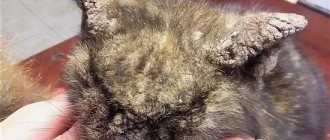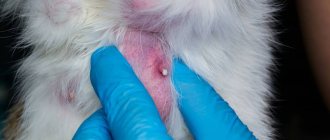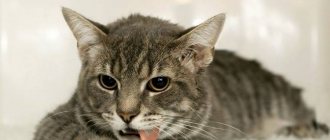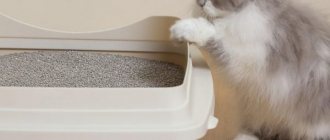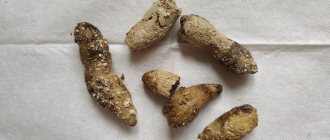Unlike dogs, a rare pathological process that occurs in domestic cats is hemorrhoids. This is a disease that develops as a result of varicose veins located in the rectum and anus.
Many cat owners are surprised to learn that their pet has hemorrhoids, as they consider the disease to be originally human. In veterinary medicine, any type of pathological process in the anal area, accompanied by inflammation, is considered hemorrhoids.
The manifestation of hemorrhoids resembles a red tumor that appears at the location of the anus. Cat owners should closely monitor the health of their pet and at the first characteristic symptoms, contact a veterinarian for help. This is due to the fact that the development of hemorrhoids has a similar clinical picture to other pathological conditions in the anal area - inflammation of the paraanal glands and rectal prolapse.
Despite the commonality of the disease, it poses a serious danger to the life of the animal. Without the necessary treatment, the pet may die. It is important to know what can trigger the development of hemorrhoids, what clinical signs are typical for it, what treatment methods exist and how pathology can be avoided.
Description
Hemorrhoids look like a red tumor in the anus.
Hemorrhoids rarely appear in cats due to their body structure and the inability to walk on their hind legs. The disease appears due to blockage of the veins. Despite the identity of the pathology with humans, its treatment in pets is different. Incorrect therapy will provoke the development of inflammation. Hemorrhoids appear against the background of deformation of the veins. The nodes gradually grow, painful sensations and bleeding appear. Disruption of the anal glands provokes a decrease in secretion, which is an antiseptic and protects the pet from inflammation.
Hemorrhoids develop in three stages. On the first, the knot looks like a small dense ball. It is not yet visible visually; it does not protrude from the anus. At the second stage, the node comes out. Visually, the ball is pale pink, cone-shaped. At the third stage, the node grows and begins to be injured during emptying. A bleeding ulcer appears, gradually developing into an open wound. This can cause infection to enter.
General information about the disease
Such a phenomenon as hemorrhoids in cats occurs quite rarely, since animals are protected from this disease by the generally somewhat different functioning of the gastrointestinal tract from humans, and by a different body structure. However, there is an illness that can not only cause a lot of inconvenience to a cat, but also cause hemorrhoids. We are talking about inflammation of the paraanal glands.
But, as far as the official data available today is concerned, hemorrhoids are considered an exclusively human ailment. And all because we can:
- walk only on two lower limbs;
- maintain balance.
This is what hemorrhoids look like in cats
That is why people suffer from hemorrhoids quite often, while animals, even those who are closely related to us (we are talking about primates), very rarely suffer from it, and this is rather considered the exception that proves the rule. On the other hand, it would be wrong to say that animals are not familiar with such an ailment as hemorrhoids. This disease, in fact, occurs due to blockage of the veins, which can easily happen in cats, dogs, other pets, farm animals, etc.
There can be many reasons that could provoke hemorrhoids or a previous disease. However, you need to understand that, despite some common signs of human and feline hemorrhoids, treating them with the same means is strictly prohibited. By choosing the wrong treatment for your cat, you may not only fail to stop the further development of the disease, but also harm the animal by provoking the further development of the inflammatory process.
The development of this disease can be provoked by completely different reasons, which are difficult to predict in advance.
Please note: any independent treatment of pets is strictly prohibited. If you have a veterinary education, you can deviate from this rule. The fact is that without proper education you are unlikely to be able to distinguish from each other:
- inflammation of the paraanal glands;
- haemorrhoids;
- other similar ailments.
So, what are hemorrhoids? This disease represents changes associated with hemorrhoidal veins, in which they occur:
- deformation;
- blockage.
Hemorrhoids mean deformation or blockage of veins, the nodes of which grow and cause pain.
The disease you are looking for can be caused by many different negative factors, but all of the factors mentioned must cause circulatory problems.
The anal glands are found in two places:
- directly inside the rectal compartment of the intestine;
- anus.
These elements of the excretory system are responsible for the production of a special substance - secretion, which serves:
- an antiseptic that protects the skin and intestinal mucosa from inflammation and the penetration of bacteria;
- a personal scent identifier through which one animal receives information about another.
Hemorrhoids and inflammation of the paraanal glands cause a lot of inconvenience to the animal
When a cat's anal glands become inflamed, the symptoms will be similar to hemorrhoids, since, as we have already said, these two diseases are literally and figuratively very close. Their symptoms are similar, so it is necessary to study them carefully so that you have the opportunity, if not to identify a specific ailment, then to notice the signs of the disease and promptly consult a doctor with your pet.
Causes
The main cause of hemorrhoids in cats is poor diet. As a result, the pet does not receive enough vitamins and minerals. The cause may be persistent hormonal imbalances or thyroid disease. Hemorrhoids also appear due to:
- dry low-quality feed;
- sedentary lifestyle;
- diseases of the digestive system;
- systematic retention of feces;
- obesity, causing protrusion of the formation;
- helminthic infestations;
- diseases of the endocrine system.
Diabetes mellitus may be the cause of hemorrhoids. It causes serious changes in the body, disruptions in the cardiovascular system. Veins lose their elasticity, and the fragility of the walls increases. This causes the veins to expand and triggers the inflammatory process.
Hemorrhoids in cats and kittens: causes
The following types of cats are at risk of the disease:
- castrati;
- cats prone to obesity;
- diabetics;
- overweight cats;
- pets with hormonal imbalances;
- older animals.
The disease develops under the influence of the following factors:
- Unbalanced diet. Pets who receive ready-made economy-class food or a random selection of natural products suffer. The greatest risk occurs when natural food and pellets are fed alternately. Constipation, straining and varicose veins of hemorrhoidal venous vessels occur.
- Overfeeding waste from cutting meat and fish. Excess protein is not completely absorbed and becomes a breeding ground for putrefactive bacteria. Indigestion develops, diarrhea alternates with constipation, overexertion during bowel movements pushes veins from the deep layers of the mucous membrane into the superficial ones.
- Obesity and adynamia lead to a slowdown in peristaltic contractions, retention and compaction of intestinal contents.
- Feeding confectionery products, fried, smoked, boiled foods disrupts the functioning of the digestive tract.
- High intestinal infestation leads to obstruction or blockage of the intestinal lumen. The load on the muscles of the anus and rectum increases. The cat strains and hemorrhoids appear.
Symptoms
When a cat has hemorrhoids, its gait changes. The pet walks with its hind legs spread out. So he tries to avoid friction in the anal area. Other symptoms of hemorrhoids include:
- loss of appetite;
- polydipsia and polyuria;
- the appearance of hemorrhoids;
- hyperemia and swelling in the anal area;
- defecation disorders (constipation, diarrhea, too hard feces, the appearance of cramps);
- apathy, lethargy;
- the appearance of bright scarlet blood and mucus in the stool.
The cat tries to be patient and rarely goes to the litter box due to severe discomfort and pain. Because of this, he may meow annoyingly and pitifully when he empties his intestines. When palpating the seal, a small ball is felt in it. Then the lump transforms into a cone, begins to grow in size and protrudes from the anus. During the process of emptying, an ulcer forms near the opening, which begins to bleed after the release of feces.
Why is it so important to visit a veterinarian?
An examination by a veterinarian ensures a correct diagnosis. After conducting all the necessary research, he will explain how to treat hemorrhoids in a kitten or adult animal and select safe dosages of medications.
In addition to confirming a specific violation, it is important to determine its cause. This will help get rid of the existing problem and prevent its occurrence in the future.
Treatment
Treatment of hemorrhoids in cats is complex. It combines drug therapy, external treatment of the node, herbal remedies, and diet. The cat is immediately switched to a balanced diet. Dry food is replaced with wet food (in bags, canned food). The diet must include fiber (vegetables) and mineral supplements that help prevent dehydration. Overly active cats should be limited in movement, and infantile ones should be called to play.
Basic treatment
Despite the fact that cats maintain their own hygiene, the owner must additionally rinse the pet’s perineum and anus with warm water. This procedure is carried out three times a day. The water must be running. Instead, you can use wet wipes, pre-soaking them with chamomile infusion. Ready-made ones can be bought at the pharmacy. After washing the anus, it is lubricated with Vaseline. The basis of treatment includes:
- At the early stage of hemorrhoids, when there are no wounds or ulcers yet, special antiseptic, anti-inflammatory suppositories are inserted into the cat’s anus, or Levomekol ointment is used.
- Remedies that eliminate the cause of hemorrhoids.
- Vein tonics that increase blood flow in the pelvic organs.
- Painkillers and thrombus-absorbing agents.
Yarrow infusion helps relieve inflammation and pain. For these purposes, Divopride candles with ichthyol are used.
Surgery
After hemorrhoids reach a severe stage, surgical treatment is required. One of two operations may be prescribed. During the first, the buds are frozen with liquid nitrogen and removed. The intervention is minimally invasive and is performed with local anesthesia. With the help of the second operation, not only the hemorrhoidal node is removed, but also the dilated sections of the veins and the adjacent mucous membrane.
After surgery, in both cases, multivitamins, wound-healing ointments (for example, Ranosan, Iruksovetin), and drugs that accelerate regeneration (Gamavit, Tsamax) are prescribed.
Diet and care
The main goals of a therapeutic diet are to return the natural consistency of stool and reduce the load on the inflamed intestines. New nutrition involves:
- Switch to easily digestible foods. All dishes are boiled or steamed, since the lack of heat treatment complicates the digestion process. You can cook rice, oatmeal or buckwheat porridge using the broth left after cooking meat.
- Chop food thoroughly before serving. Too large an unchewed piece can injure the mucous membrane.
- Enriching the diet with fiber and vitamins. Use special probiotics, vitamin complexes or bran soaked in kefir. Remember that all fermented milk products must have minimal fat content and an expiration date.
- Switching to veterinary food. The lack of water is compensated for with wet canned food from the same line, intended for the treatment of gastrointestinal pathologies.
In addition to changing your diet, it is important to reconsider your existing load. Fluffy couch potatoes are encouraged to play actively, and pets that are too restless are temporarily restricted in their movements.
Before recovery, you need to take care of hygiene. Clean the anus and perineum twice daily with warm water or alcohol-free wipes. After washing, be sure to lubricate the anus with antiseptic ointment or Vaseline oil. This will prevent infection from entering the wound and speed up its healing.
Prevention
To prevent hemorrhoids, treatment for helminths is carried out every six months. The cat should be provided with a balanced diet, vitamins, and access to clean water. If the pet is accustomed to dry food, it should alternate with soft food.
If diarrhea or constipation persists, your cat should be taken to the vet immediately. If the pet is not careful enough about personal hygiene, then the owners need to clean the anus themselves. It is important to control your cat's weight. If there are signs of obesity, provide diet and exercise.
Hemorrhoids in cats are easily diagnosed and can be successfully treated in the initial stages. At later times, only through operations. Pets are difficult to tolerate the disease. The only scary complications after hemorrhoids are bleeding, infection and the development of additional pathologies. However, hemorrhoids are rare in cats, more often in old age.
What is hemorrhoids confused with?
Inflammation of the glands of the paraanal area - in the anal area there are 2 anal glands, which are the source of secretion for marking the territory and for antiseptic action after defecation. When the excretory ducts are blocked, abscesses form, which can rupture and cause bleeding. The main treatment consists of removing pus from the ducts.
Rectal prolapse - occurs when the anal sphincter muscles fail, during difficult childbirth in a cat and frequent diarrhea. In appearance, the prolapsed intestine resembles an oblong cylinder of bright scarlet or bluish-burgundy color, which swells rapidly from compression by the sphincter muscles. This pathology requires mandatory surgical treatment and immediate contact with a veterinary clinic.
Hemorrhoids in a cat: how to treat at home
Conservative treatment consists of the following:
- Diet therapy : creating a diet and using it to prepare veterinary food at home is difficult. Therefore, you should switch to ready-made food of at least premium class. Feeding only pellets will irritate the inflamed colon. Therefore, the physical form of the feed should be alternated. For example, in the morning they give croquettes, in the evening wet food in a pouch, preferably from the same manufacturer.
- Deworming . Complex antihelminthic drugs are used.
- Sanitation of the anus. After defecation, the anus is washed with warm water without soap and lubricated with antiseptic anti-inflammatory ointment, for example, Levomekol. In case of severe inflammation, rectal suppositories with ichthyol or furatsilin are used according to the instructions for use.
If the measures taken do not help, contact the clinic, where a veterinarian performs surgical treatment.
Classification of painkillers by release form
Hemorrhoids are a well-studied problem, so prevention and treatment methods always guarantee a good result. Despite the wide selection of drugs in pharmacies, only the attending physician can prescribe complex therapy after a thorough diagnosis of the problem. The form of release of drugs is selected depending on the individual preferences of the patient and the complexity of the symptoms. The most effective and acceptable forms of drug release are suppositories, ointments and tablets.
Candles
In an acute inflammatory process, it is extremely difficult to anesthetize a pronounced pain syndrome, because First you need to stop the swelling. Many proctologists advise the use of local anesthetics, which simultaneously relieve inflammation, relieve pain and promote the regeneration of anal fissures. The main advantages of local drugs:
- Minimum contraindications and side effects;
- Acts directly on the source of inflammation;
- Effective rate of absorption and symptom relief.
Unlike tablets, suppositories are used only for internal hemorrhoids. The neurotropic principle of action of the drug allows you to relieve pain by blocking the conduction of nerve impulses from the location of the “bumps” to the neurons of the brain.
Ointments and gels
Used for external and internal hemorrhoids. The main advantages of the drugs are ease of use, uniform distribution of the active substance and high absorption rate. The analgesic effect is achieved by relieving swelling and inflammation, narrowing the vessels of varicose veins, regenerating cracks and the antibacterial effect of the ointment. Among the names of popular products are Proctosan, Relief Advance, Proctosedyl.
Painkillers for hemorrhoids
Efficient and effective systemic drugs in the fight against the symptoms of hemorrhoids are venotonic and agnioprotective tablets. According to the principle of action, drugs can be divided into 2 types:
- Tablets that have only an analgesic effect. Their action is aimed at reducing painful symptoms. Painkillers have many contraindications, and the course of treatment cannot exceed several days.
- Systemic tablets with a dose-dependent effect can not only relieve attacks of pain, but also have a beneficial effect on the general condition of blood vessels. They affect the cause of the disease, increase venous tone, improve lymphatic drainage, increase vascular stability, thereby reducing inflammation of the nodes. Effective healing of cracks and microtraumas of the anal mucosa is achieved due to its regenerating properties. The most recommended tablets from this group are called “Phlebodia” and “Detralex”.
Before diagnosing yourself and treating the symptoms of the disease, you should consult a proctologist. Many drugs have contraindications and a special dosage regimen, without taking into account which you can harm your health and aggravate the course of the disease.
What to feed a cat with constipation
After a cat has been diagnosed with hemorrhoids, what to do next? First of all, owners will have to switch their pets to proper and balanced nutrition. In this case, it is recommended to completely abandon the use of dry food.
The cat is transferred to canned food of exceptionally high quality. The bottom line is that cheap manufacturers use low-quality and sometimes harmful raw materials. Such food can only make the situation worse.
Food prepared independently will also have a positive effect on the animal’s condition. It is necessary that the diet necessarily include meat and vegetables. If the cat is dehydrated, additional minerals are added. It is also worth ensuring that the animal has constant access to water.
Diagnosis of the disease
Hemorrhoids in a cat and how to treat it depend on what caused it, since such an ailment is very unusual for representatives of the cat family. Blood clotting will need to be checked. For this purpose, a coagulogram is performed.
In addition, doctors recommend testing animals for hormones and determining blood sugar levels. It is also necessary to check the stool for the presence of parasites and their eggs. In addition, the veterinarian examines the anus and evaluates the general condition of the anal glands.
Why does pathology develop?
Some people are convinced that hemorrhoids can only occur in humans. This opinion is due to upright posture and the load on the lower body area, which is not inherent in animals. However, this statement is incorrect, since varicose veins on the anus can be diagnosed in cats. The disease develops due to the influence of the following factors:
- disturbance of vascular tone;
- changes in blood properties;
- excessive body weight;
- diabetes;
- systematic constipation;
- unhealthy diet;
- hormonal imbalance.
